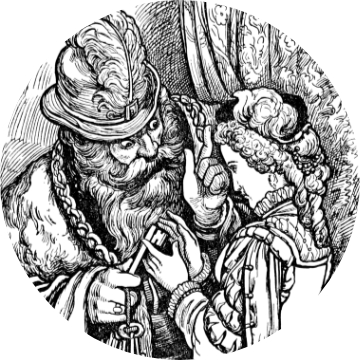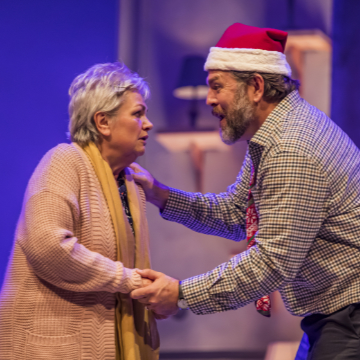October 7, 8 & 9, 2022
Morgan Concert Hall, Bailey Performance Center
Kennesaw, Georgia – USA
Co-presenters: The Atlanta Opera & KSU College of Arts
Co-production: Theatre of Sound & Opera Ventures
Stephen Higgins, conductor; Daisy Evans, production director. Cast: Susan Bullock (Judith), Michael Mayes (Duke Bluebeard), Eva Lukkonen (1960’s Judith), Marissa Romanoff (1980’s Judith), Mary Beth Morrison (1990’s Judith), Coleman Hand (Son); Thainara Carvalho (Daughter). Creative: Adrian Linford, scenic & costumer designer; Jake Wiltshire, lighting designer; Melanie Steele, wig & makeup designer.
Béla BARTÓK: Bluebeard’s Castle
Mark Gresham | 12 OCT 2022
This is a love story. It was not always so.
Such stories often change with time. They can even go unremembered.
This is also a story about memory. And time. And age.
Such remembered stories find their retellings in different forms, passed on between different generations. We often need to reach back into our sometimes dim, largely unconscious collective memory of folk tales to better understand their retelling in our contemporary world, especially when the retelling reveals new meanings.
In this case, the tale of Bluebeard, an homme fatal, a wealthy man in the habit of murdering his wives, and his defiant, final wife who attempts to avoid the fate of her predecessors.

Bluebeard gives his wife the keys to his castle in this woodcut by Gustave Doré for Les Contes de Perrault (Paris, Jules Hetzel, 1862)
The homme fatal archetype of a powerful, seductive, dangerous man is as old as storytelling itself. But this particular tale took literary root in the seventeenth century in story of Le Barbe bleu by Charles Perrault, the iconic 17th-century French author who laid the foundations for a new literary genre: the fairy tale.
The Bluebeard story and the homme fatal archetype retained an appeal that resonated with 19th and 20th-century culture in various forms, influencing writers, dramatists, and filmmakers. Bran Stoker’s novel Dracula (1897), George Cukor’s 1944 film Gaslight, and films of Alfred Hitchcock (e.g. Suspicion, 1941).
Hungarian composer Béla Bartók was one of those early 20th-century creators intrigued by the story. In his 1911 opera A kékszakállú herceg vára (Duke Bluebeard’s Castle) with a libretto by poet Béla Balázs, one can see the evolution of Bluebeard’s story from Perrault to a more modern, if still Gothic telling. The Budapest Opera gave its premiere in 1918.
This version of Bluebeard’s Castle presented by The Atlanta Opera and the College of Arts at Kennesaw State University this past weekend took Bartok’s opera more than a few steps further in a co-production by Theatre of Sound and Opera Ventures.
With a new English libretto by stage director Daisy Evans and a distillation of Bartók’s orchestral score for chamber septet by conductor Stephen Higgins, this is the same version that premiered at Stone Nest, a former Welsh chapel in London’s West End (UK), in November 2021.
As Evans explained in last week’s interview with EarRelevant:
That openness to interpretation invited Evans to move the story away from Bluebeard as an homme fatal and change the character of his wife from a stock ingénue new bride who is defiantly curious to a long-time spouse of his own age who is suffering the ravages of dementia, and its deleterious impact upon their loving relationship. Says Evans:
She began to ponder what Bluebeard’s “other three wives” introduced near the opera’s end symbolized. Bluebeard calls them the wife of his morning, the wife of his midday, and the wife of his sunset, then says that Judith is the wife of his nighttime.
Evans’ conclusion: this was not four wives but one Judith and four stages of one relationship. The first three are Bluebeard’s memories of each throughout their relationship: Judith in the 1960s, 1980s, and 1990s. Each Judith is a “presence” reintroduced to Judith as she struggles to remember her past.

Four faces of Judith (l-r): Eva Lukkonen (1960’s), Susan Bullock (present day), Marissa Romanoff (1980’s), Mary Beth Morrison (1990’s). (credit: Raftermen)
Instead of a foreboding castle, the setting is a comfortable suburban home. Instead of seven doors to open, a single trunk in the living room offers artifacts that jog attempts at memory on the part of Judith and more vivid, loving recollections on the part of Bluebeard, which he desperately tries to communicate to her.
In last weekend’s performances at the 624-seat Morgan Hall, located within KSU’s Bailey Performance Center, soprano Susan Bullock sang the role of Judith, and baritone Michael Mayes portrayed Duke Bluebeard. Both were in splendid form in their singing and acting. They were the sole singers in the opera, although not the only actors on the stage. The new libretto dispenses with a spoken prologue, so all these other characters are silent: The three apparitions of Judith Past (Eva Lukkonen, Marissa Romanoff, and Mary Beth Morrison) and memories of the couple’s son and daughter (Coleman Hand and Thainara Carvalho).
Higgins’ transcription of the music for septet, securely performed by members of The Atlanta Opera Orchestra, is excellent and does justice to supporting and reflecting the intimately intense drama onstage.
In this Bluebeard’s Castle, we got an emotionally moving hour-long drama that was a poignant reminder of the passing of time, the perseverance of love in the face of age and loss, and the frail persistence of memory that holds its sense of reality together.
We anticipate a film version of these performances of Bluebeard’s Castle will become available on The Atlanta Opera’s Spotlight media streaming platform, although we do not yet know when that will come to pass. We urge readers to remember to watch for it and make a point of seeing it when it does. ■
EXTERNAL LINKS:
- The Atlanta Opera: atlantaopera.org
- Susan Bullock: harrisonparrott.com/artists/susan-bullock
- Michael Mayes: michaelmayesbaritone.com
- Daisy Evans: daisy-evans.com
- Stephen Higgins: connaughtartists.com/index.php/stephen-higgins
- Theatre of Sound: theatreofsound.org

Mark Gresham is publisher and principal writer of EarRelevant. he began writing as a music journalist over 30 years ago, but has been a composer of music much longer than that. He was the winner of an ASCAP/Deems Taylor Award for music journalism in 2003.









.png)